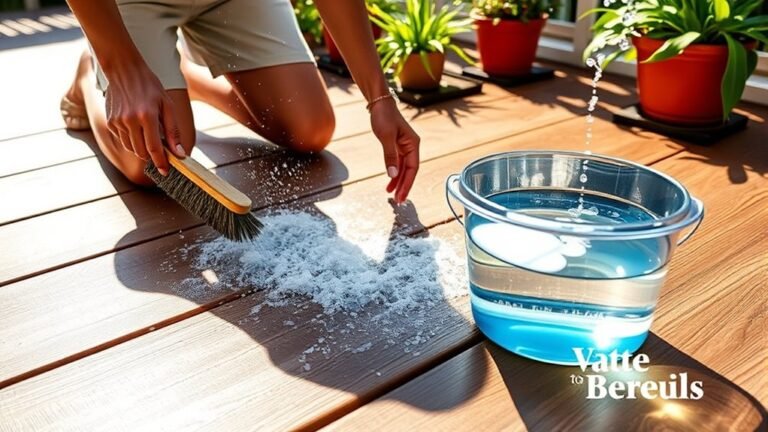How to Remove Paint Stains From Floors
To remove paint stains from your floors, first identify the type of paint and floor surface to choose the safest method. For fresh spills, gently blot with a damp cloth and mild soap. For dried paint, try softening with heat or household items like vinegar, then scrape carefully with a plastic tool. Always test on hidden spots to avoid damage. Protective coverings can prevent future stains. If you want to tackle stubborn spots or learn smart prevention tips, keep exploring these effective solutions.
Identifying the Type of Paint and Floor Surface

Before you tackle paint stains on your floor, it’s important to figure out what kind of paint you’re dealing with and what type of floor surface you have. Different paint types—like water-based latex or oil-based—react differently when you try to remove stains. Knowing this helps you choose the safest method without damaging your floor. Likewise, floor materials vary greatly; hardwood, tile, vinyl, or concrete each require specific care. For example, hardwood can be sensitive to harsh chemicals, while tile might handle stronger cleaners. By identifying both paint types and floor materials upfront, you gain the freedom to act confidently and preserve your floors’ integrity. This step sets you on the right path toward effective, damage-free paint stain removal.
Removing Fresh Paint Stains Safely
Since fresh paint hasn’t had time to dry, you can usually remove it more easily and with less risk of damage to your floor. For fresh paint removal, start by gently blotting the area with a damp cloth to lift excess paint. Avoid rubbing, which might spread the stain or damage the surface. Use mild soap mixed with water for safe cleaning, ensuring you don’t use harsh chemicals that could harm your floor’s finish. If needed, a plastic scraper can help lift paint without scratching. Always test any cleaning solution on a small, hidden spot first to protect your floors. Acting quickly and carefully gives you the freedom to keep your floors spotless without risking permanent stains or damage.
Techniques for Eliminating Dried Paint Spots

Though dried paint is tougher to remove than fresh spills, you can still tackle it effectively with the right approach. Start by softening the paint using a heat gun or warm soapy water, then gently scrape with a plastic scraper to avoid floor damage. Here’s a quick guide to paint removal techniques and floor cleaning methods:
| Technique | Tools Needed | Best For |
|---|---|---|
| Heat Softening | Heat gun, scraper | Hard floors |
| Soap & Water | Warm water, sponge | Sealed wood floors |
| Chemical Remover | Paint remover, gloves | Tough spots |
| Sanding | Fine sandpaper | Wood floors only |
| Scraping | Plastic scraper | Tile and vinyl |
Choose a method that suits your floor type and go for freedom from stains!
Using Household Items to Lift Paint From Floors
If you don’t have specialized tools on hand, you can often rely on common household items to lift paint from your floors. Here’s how you can tackle those stubborn paint stains with freedom and ease:
- Mix a vinegar solution (equal parts vinegar and water) and apply it to the stain. Let it sit for a few minutes to soften the paint.
- Sprinkle baking soda over the vinegar-treated area to create a gentle abrasive.
- Use a soft cloth or sponge to scrub the spot gently, lifting the paint without damaging your floor.
- Rinse with warm water and dry thoroughly.
These simple steps use what you already have, giving you the freedom to clean effectively without extra costs or harsh chemicals.
Specialized Products for Stubborn Paint Residues

When household items don’t quite do the trick, specialized products can help you tackle stubborn paint residues more effectively. Products like paint thinner and adhesive remover break down tough paint without damaging your floor, giving you the freedom to restore your space quickly. Always test a small area first to verify compatibility.
| Product | Best For |
|---|---|
| Paint Thinner | Oil-based paint stains |
| Adhesive Remover | Sticky, dried paint |
| Citrus Solvent | Gentle on sensitive floors |
| Rubbing Alcohol | Small, fresh spots |
| Commercial Paint Remover | Heavy-duty removal |
Using these targeted solutions lets you regain control and keep your floors looking flawless.
Preventative Measures to Avoid Future Paint Stains
To keep your floors paint-free, start by using protective floor coverings like drop cloths or plastic sheets whenever you paint. Setting up a designated painting area can also help contain any mess. These simple steps will save you time and effort when cleaning up later.
Use Protective Floor Coverings
Three simple types of protective floor coverings can save you from the hassle of removing paint stains later: drop cloths, plastic sheeting, and painter’s tape. To keep your floors free and clear, consider these options:
- Lay down protective tarps or heavy-duty drop cloths to catch spills without sticking.
- Use plastic sheeting for a waterproof barrier, especially in high-traffic or messy areas.
- Place floor mats near entrances to prevent tracked-in paint or dirt.
- Apply painter’s tape along baseboards and edges to create clean lines and protect surfaces.
Establish Designated Painting Areas
Protective floor coverings help minimize paint spills, but setting up specific painting zones takes prevention a step further. By creating designated zones for your painting setup, you gain control over where paint can go, keeping your floors safe and your space organized. Choose an area with easy-to-clean surfaces and enough room to move freely without worrying about stray drips. Use drop cloths or plastic sheeting to define these zones clearly, and keep all your supplies contained within them. This approach not only reduces cleanup time but also lets you enjoy painting without restrictions. When you establish dedicated zones, you’re setting boundaries that protect your floors while still giving you the freedom to express your creativity confidently and mess-free.
Frequently Asked Questions
Can Paint Stains Damage My Floor’s Finish Permanently?
Don’t worry, paint stains won’t always ruin your floor’s finish permanently—especially if your floor has good paint durability and floor protection. However, if you leave stains untreated, they can seep in and cause lasting damage. You’ve got the freedom to act quickly and preserve your floor’s beauty. Just be cautious and clean spills as soon as possible to keep your floors looking fresh and protected for years to come.
How Do I Dispose of Paint Removal Waste Safely?
When dealing with paint disposal, you’ve got to be mindful of waste management rules to keep things safe and eco-friendly. Don’t just toss leftover paint or removal waste in the trash—it can harm the environment. Instead, check with your local hazardous waste facility for proper drop-off options. You’ll feel freer knowing you’re handling waste responsibly, keeping your space clean and the planet happy. Always follow local guidelines to stay on the right side of the law.
Are There Eco-Friendly Paint Removal Alternatives?
Imagine you’re in a Victorian parlor, seeking freedom from harsh chemicals. You’ll love eco-friendly paint removal alternatives like natural cleaners. These include a vinegar solution mixed with water, which gently breaks down paint without harming the environment. You don’t have to be tied down by toxic substances—opting for these green methods lets you reclaim your space while respecting the planet. It’s freedom for you and nature alike.
Can I Use a Heat Gun to Remove Paint From Floors?
You can use a heat gun to remove paint from floors, but you’ve got to prioritize heat gun safety first. Keep the gun moving to avoid scorching the floor, and work in a well-ventilated space to dodge fumes. Heat gun paint removal techniques let you soften the paint for easy scraping, giving you more control and less mess. Just remember, patience is key—you’re in charge of how smoothly it goes!
How Long Should I Wait Before Walking on Cleaned Areas?
You’ll want to give the cleaned areas enough drying time before walking on them to avoid smudging or damaging the finish. Typically, waiting at least 24 hours is best, but it depends on the cleaning method and floor type. If you’re in a rush, try to limit foot traffic for as long as possible. Patience here means freedom later—your floors will look great, and you won’t have to redo the work.






